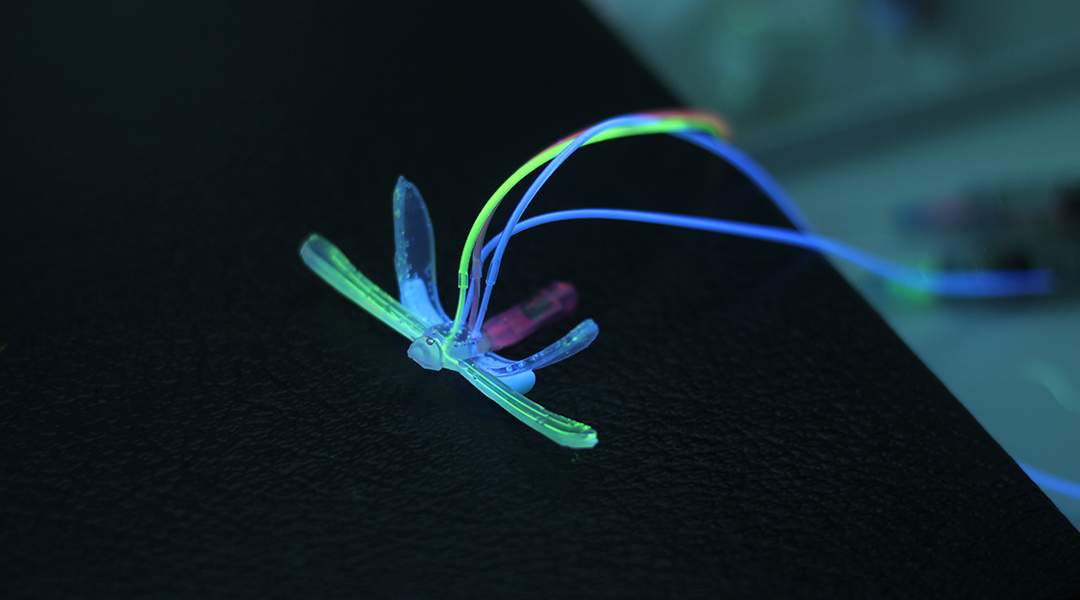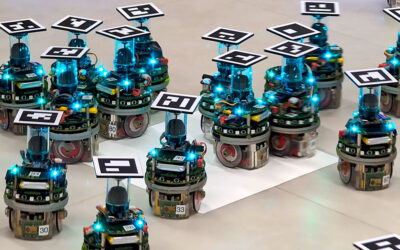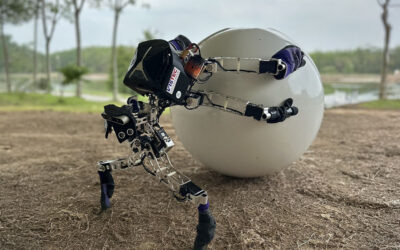A recent study from a team of researchers led by Shyni Varghese, professor at Duke University, has reported a smart soft robot called DraBot that exhibits controlled skimming motion over water surfaces with environmental sensing capabilities. The proof-of-concept demonstration could be a precursor to more advanced, autonomous, long-range environmental sentinels for monitoring a wide range of potential telltale signs of problems, such as pH changes or the presence of oil.
Soft robotics is an emerging research area that focuses on creating devices using compliant materials, such as hydrogels and elastomers. The soft materials allow these robots to explore constrained environments where conventional robots based on hard materials cannot go and perform delicate tasks while passively interacting with surrounding environments.
Owing to these unique characteristics, soft robots have been used to create surgical tools that will inflict less damage on tissue, as exosuits where soft robots can create flexible outer layer that does not restrict the movements of rigid materials, and as artificial biosystems for environmental monitoring and healthcare. Design principles that incorporate smart and biomimicking materials could significantly advance the function of soft robots to carryout specialized or broad tasks.
The current study uses a simple material design that integrates stimuli-responsive smart materials and microengineering to create a skimming soft robot that can sense and adapt to environmental changes.
“We based the structural design of our skimming soft robot on the body plan of a dragonfly as skimmers are the most common family of dragonflies, hence the name DraBot,” explained Vardhman Kumar, the first author of the study and a Ph.D. student in biomedical engineering. “This entirely soft robot is fabricated out of silicone elastomers using microfabrication and is decorated with multiple functional elements such as flexible actuators and stimuli-responsive and self-healing materials at different locations on its body to incorporate sensing capabilities.”
Microfluidic and air microchannels embedded within the robot’s body control its locomotion. “The front wings of the robot consist of air channels while the back wings consist of microfluidic channels that enable flapping movement of the wings via balloon actuators,” explained Dr. Ung Hyun Ko, co-first author of the study and a postdoctoral fellow in Varghese’s research group. “The air channels in front wings direct the airflow backward towards back wings thus propelling the robot forward using jet propulsion. Precise control over forward movement, taking a turn and coming to a stop is enabled by flapping of the back wings via flexible actuators.”
In addition to exhibiting complex motion, the robot is designed to sense and adjust to its environment thus bringing it closer to mimicking living systems. “Our lab has developed several stimuli-responsive hydrogel systems – one of them being pH-responsive, self-healing hydrogels wherein exposure to low pH results in instantaneous healing of individual hydrogel pieces. This process is reversible and exposure to a high pH separates the hydrogels,” said Varghese. “Incorporation of such self-healing materials in soft robotics can be used to enhance their function.”
In the case of DraBot, the hydrogel was incorporated onto one side of the wings. When the robot encounters an acidic condition, the wings heal together, which disables the flapping. This impairs the forward motion of the robot causing it to take a turn – thus acting as a sensing and reporting mechanism for water acidity.
Another feature of the DraBot is its changing wing color in response to changes in temperature — a trait that it shares with certain species of dragonflies that exhibit temperature sensitive color change in certain body parts. Microporous hydrophobic structures present in the wings and abdomen help the robot stay afloat and assist with locomotion, and also have the capability to absorb hydrophobic impurities, such as oil.
Thus, when DraBot passes through a region with oil contamination on the water surface, it absorbs the oil within these microporous structures. While this proof-of-concept studies demonstrate the potential of such multi-functional robots, one could foresee a number of applications. The pH-responsive change in motion could be used to detect freshwater acidification (a problem affecting geologically-sensitive regions), temperature dependent color change can be used to detect changes in temperature of water bodies (associated with red tides) and oil-absorption feature can be leveraged to detect early signs of oil spill.
“The future of smart robotics certainly lies at the interface of soft and hard robotics — incorporating the best of both worlds. In terms of DraBot, future prototypes might incorporate on-board energy source/fuel reservoir that might help us eliminate the use of tubings that can entangle in long runs and limit the range of travel distance,” explained Varghese. “Integration of wireless cameras to the robot will further enhance its reporting abilities. One could also incorporate living systems and biological sensors within these robots.
“The field of soft robotics is relatively new and its potential in fields such as environmental protection and healthcare is truly endless.”
Reference: Vardhman Kumar, et al., Microengineered Materials with Self‐Healing Features for Soft Robotics, Advanced Intelligent Systems (2021). DOI: 10.1002/aisy.202100005

















